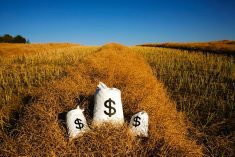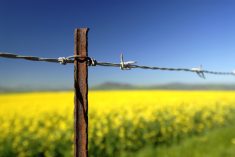More than 500 tractors made their way to the motorways linking to Paris on Jan. 29, as walls of hay rose here and there in the capital’s arteries.
French farmers vowed to blockade the Paris region until their demands are met, and kept up pressure ahead of a European summit on Feb. 1. On Jan. 31, more than 100 roads were blocked and 10,000 people demonstrated across the country, according to the French interior ministry.
Prime Minister Gabriel Attal, just named to lead the government, grappled with his first crisis, with grievances focused on new environmental norms, fuel taxes, free trade and wages. Formerly education minister, the 34-year-old attempted to quell the unrest by granting emergency subsidies for organic farmers, cattle farmers hit by epizootic hemorrhagic disease and bad weather, and suspending a tax hike on tractor fuel.
Read Also

Guarding against misinformation: Do you believe in house hippos?
Misinformation and disinformation run rampant in today’s digital age. Farmers must be wary of the digital dangers and know how to keep themselves safe.
To the trade-unions steering the protests, however, it was too little, too late.
READ MORE: Italy’s farmers head to Rome in tractor convoy protest
READ MORE: Tractors choke Spanish city streets as farmers protest EU policy
READ MORE: India security forces fire tear gas at protesting farmers on drive to Delhi
The roots of discontent
The demonstrations were in the making for some time. In late 2023, farmers had already started turning road signs upside down to protest governmental red tape. The name of the farmers’ initiative echoes the sentiment: “On marche sur la tête”, meaning “We’re walking on our heads.” It’s a common idiom that refers to an upside-down world.
Speaking to the TV channel TF1 in late January, Luc Smessaert, a cattle farmer in the Oise region north of Paris, voiced such feelings.
“Nowadays, [a] hedge is subject to 14 different European and French laws — the code on urbanism, heritage, and environment. Farmers don’t even want to plant hedges anymore.”
In 2021, organic farmers photographed themselves naked in their fields holding a sign “La Bio à Poil” – the literal meaning in French is “in the nude”, but there’s also the sense of being exposed and vulnerable – to raise awareness over political ambiguity around agro-ecological practices.
Europe-wide grievances
Unlike the “Gilets Jaunes” or pension-reform protests, the uproar isn’t unique to France. Since 2022, farmers in the Netherlands, Germany, Italy, Poland, Romania and Lithuania have been setting up shop outside government quarters and camping tractors and forestry trucks on main roads.
Buoyed by the actions of their French peers across the border, Belgian farmers blocked the roads to Zeebrugge port on Jan. 30.
The discontent took place days after the European Commission launched its much-trumpeted strategic dialogue on the future of agriculture and just ahead of the European elections.
While these movements are not new, they are becoming increasingly confrontational.
French farmers know they largely have the public’s support, and it’s relatively easy for them to gain the attention of politicians and the media.
However, past examples show that such movements can be quickly forgotten once the heat of the protest past. So, did earlier protest movements serve a purpose?
Whatever farmers grow in France and however they do it, they have to juggle an increasing number of competing demands: how to feed France while caring for the environment while complying with ever more regulatory standards, and coping with the immediate impacts of frost, floods and drought.
How do they meet society’s expectations for more organic farming, even as inflation rises and consumption declines? Conversions to agro-ecological methods are costly and often require several years.
Many farmers believe current economic conditions make it impossible to reconcile the demands of sustainability and development, yet be able to pass their farms on to the next generation.
Juggling these contradictions places a considerable physical, psychological and emotional burden on farmers, culminating in the societal and moral crisis of today.
A look at the responses to previous protest movements shows that farmers’ anger is generally heard, at least in part.
The “La Bio à poil” movement helped farmers secure a number of wins, including a EU$1million promotion campaign for the sector and subsidies for pig farming. As part of the reforms of EU’s Common Agricultural Policy, the organic farmers’ union also clinched higher subsidies for its conservation practices. In 2022, they said they were happy with the progress made.
Actions by the “On marche sur la tête” movement led the government to back down on a tax hike for pesticides, originally intended to spread the burden of depollution costs faced by water providers.
Likewise, the head of the country’s mainstream agriculture trade union, the FNSEA, said it was “satisfied” with its win on what they called a “major demand.”
As far as the current upsurge of anger is concerned, measures and compensation will no doubt be announced. But will they be enough to solve the impossible equation facing agriculture in the long term? There’s also the risk that new measures may increase perceived contradictions and paperwork.
Since 2019, we have been following 42 farmers from the Centre–Val de Loire region, to research how they navigate these tensions.
We found that such political movements provide an important outlet, allowing them to express the anger they feel. In France, suicide has hit the farming world more than the general population. Uniting with others in similar situations allows them to break free from feelings of isolation.
Protests also allow farmers to define for themselves what a viable agricultural model would look like. For politicians and the rest of us, such protests provide an opportunity to show our attachment to the farming world as well as a certain rural ideal.
If anything is to come from these protests, politicians and citizens will need to play their part in facing up to their own contradictions. A November 2023 survey found that the French are asking for more financial support from public authorities (56 per cent), but there is still a high proportion in favour (25 per cent) of maintaining aid to farmers as it is.
So what is to be done? It could be a matter of empowering farmers in the face of supermarkets and retailers pushing for high prices.
It could also be a matter of consumers making an effort to consume locally and at the right price, and accepting a countryside in which farming is a profession and not just landscapes. It might also be a question of providing greater support for R&D to ease the agro-ecological transition.















